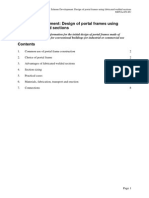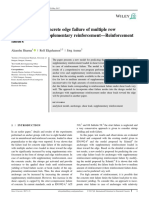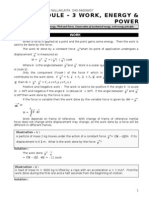NCCI PN 001a - Stud Strength
NCCI PN 001a - Stud Strength
Uploaded by
ravisbadryCopyright:
Available Formats
NCCI PN 001a - Stud Strength
NCCI PN 001a - Stud Strength
Uploaded by
ravisbadryCopyright
Available Formats
Share this document
Did you find this document useful?
Is this content inappropriate?
Copyright:
Available Formats
NCCI PN 001a - Stud Strength
NCCI PN 001a - Stud Strength
Uploaded by
ravisbadryCopyright:
Available Formats
NCCI: Resistance of headed stud shear connectors in transverse sheeting (GB) Discuss me ...
NCCI: Resistance of headed stud shear connectors in transverse sheeting PN001a-GB
Localized resource for UK
NCCI: Resistance of headed stud shear connectors in transverse sheeting
This NCCI gives rules for determining design resistance values for 19 mm headed shear studs on beams with transverse trapezoidal decking. The design values are based on values given in BS EN 1994-1-1, modified by a factor that has been derived from the analysis of experimental investigations involving beam tests and push tests.
Contents
1. 2. 3. 4.
Created on 16 August 2011 This material is copyright - all rights reserved. Use of this document is subject to the terms and conditions of the Steelbiz Licence Agreement
General Resistance values Example Commentary References
2 2 4 5 6
5.
Page 1 of 7
NCCI: Resistance of headed stud shear connectors in transverse sheeting (GB) Discuss me ...
NCCI: Resistance of headed stud shear connectors in transverse sheeting PN001a-GB
1.
General
The design shear resistance of headed stud connectors used with profiled decking spanning perpendicular to the beam is given by BS EN 1994-1-1, 6.6.4.2 as that of a solid slab PRd multiplied by a reduction factor kt. The factor takes account of the geometry of the stud, the geometry of the decking, and the number of studs per trough; it was derived using an extensive body of evidence from push tests carried out over a long period of time and covering a wide range of parameters. Two equations are given in BS EN 1994-1-1, 6.6.3.1 for the resistance of a stud in a solid slab: for a failure governed by shearing of the steel (Equation (6.18)); and for a shear failure of the concrete (Equation (6.19)). The resistance PRd is the lesser of these two values. The expressions for design values of shear resistance in a solid slab in BS EN 1994-1-1, 6.6.3.1 include division by the partial factor V. The UK National Annex (clause NA.2.4) adopts the recommended value of V = 1.25 unless stud resistances given in noncontradictory complementary information would justify the use of an alternative value. Current practice, using modern trapezoidal decks, is to provide only a single layer of mesh and the position of that mesh does not comply with the requirement in BS EN 1994-1-1, 6.6.5.1 that there should be a clear distance of at least 30 mm above it and below the underside of the head of the stud. However, although not explicitly stated in BS EN 1994-1-1, it is believed that that detailing requirement should only be applied to solid slabs. (Indeed, its reference to lower reinforcement is meaningless for a composite slab, which usually has only a single layer of mesh.) Recently, beam tests and push tests have been carried out using these modern trapezoidal decks and a single layer of mesh reinforcement. Design values were determined for 19 mm diameter headed stud connectors with an as-welded height not less than 95 mm. As a result of the experimental work, modification factors which can be applied to the design resistance values given by BS EN 1994-1-1 have been derived for this situation; the modification factors may be applied to the values given by BS EN 1994-1-1 as an alternative to the modification of V that is permitted by the UK NA. The modified design values of resistance, determined using V = 1.25 give good agreement with values derived from testing.
Created on 16 August 2011 This material is copyright - all rights reserved. Use of this document is subject to the terms and conditions of the Steelbiz Licence Agreement
2.
Resistance values
The design shear resistance of headed stud connectors in trapezoidal decking with ribs transverse to the beam may be calculated in accordance with BS EN 1994-1-1, 6.6.4.2, provided that the resistance value given by BS EN 1994-1-1, Equation (6.19) (i.e. the resistance of the concrete) is modified by use of a factor kmod given in Table 2.1. For these modified design resistances, the detailing does not need to comply with BS EN 1994-1-1, 6.6.5.1, The modification factor kmod may be applied when the following conditions are satisfied:
The height of the trapezoidal decking, as defined below, is not less than 35 mm nor
greater than 80 mm
Page 2 of 7
NCCI: Resistance of headed stud shear connectors in transverse sheeting (GB) Discuss me ...
NCCI: Resistance of headed stud shear connectors in transverse sheeting PN001a-GB
The height of the trapezoidal profile may be calculated excluding any small re-entrant
stiffener to the crest of the profile, provided that the width of the crest of the profile is not less than 110 mm and the stiffener does not exceed 15 mm in height and 55 mm in width.
The mean width of the troughs of the decking is not less than 100 mm The number of stud connectors in one rib at a beam intersection is not more than 2 The nominal diameter of the studs is 19 mm with an as welded height of at least
95 mm.
The ultimate strength of the studs fu should not be taken as greater than 450 N/mm The as welded height of the studs is at least 35 mm greater than the height of the
2
trapezoidal profile, as defined above
The nominal thickness of the trapezoidal profile sheeting is not less than 0.9 mm (bare
metal thickness 0.86 mm).
Where there is a single stud connector per trough, it should be placed in the central
position. If this is not possible, studs should be placed in the favourable position*. The resistance of studs in the favourable position may be assumed to be the same as that in the central position.
Created on 16 August 2011 This material is copyright - all rights reserved. Use of this document is subject to the terms and conditions of the Steelbiz Licence Agreement
Where there are two studs per trough, they should both be placed in the central
position, or in the favourable position. Where this is not practical the studs may be staggered, one either side of the central position. The resistance of a pair of staggered studs may be assumed to be the equivalent of two central studs.
Table 2.1 Factor to apply to solid slab design shear resistance values derived from BS EN 1994-1-1, 6.6.3.1 Equation (6.19) using V = 1.25
Position of mesh1 Above the heads of the studs At least 10 mm below the heads of the studs Above the heads of the studs At least 10 mm below the heads of the studs kmod 1.0 1.0 0.7 0.9
Number of studs per trough 1 1 2 2
Notes: 1 Positioning the mesh below the heads may have practical implications.
As defined by SCI advisory desk note AD 040, a favourable location is where the zone of concrete in compression in front of the stud is larger than that behind the stud. Page 3 of 7
NCCI: Resistance of headed stud shear connectors in transverse sheeting (GB) Discuss me ...
NCCI: Resistance of headed stud shear connectors in transverse sheeting PN001a-GB
3.
Example
For a 95 19 mm headed stud shear connector with fu = 450 N/mm through-deck welded into a 0.9 mm gauge transverse trapezoidal deck for which kt = kt,max, with a slab of C25/30 concrete and mesh above the heads of the studs: The resistance of a stud in a solid slab is given by BS EN 1994-1-1 as follows: Equation (6.18) gives: PRd
0.8 f u d 2 4
0.8 450 19 2 4 = 81.7 kN 1.25 0.29 1.0 19 2 25 31103 = = 73.7 kN 1.25
Equation (6.19) gives: PRd
0.29 d 2
f ck Ecm
For situations where this NCCI applies, the value given by Equation (6.19) should be multiplied by the appropriate kmod value from Table 2.1. Case (1): A single stud per trough, with the mesh positioned above the heads of the studs.
Created on 16 August 2011 This material is copyright - all rights reserved. Use of this document is subject to the terms and conditions of the Steelbiz Licence Agreement
kmod = 1.0 and the resistance given by Equation (6.19) is modified, as follows. PRd = 73.7 x 1.0 = 73.7 kN The design resistance is then calculated using the minimum value from Equation 6.18 (81.7 kN) and the modified value from Equation 6.19 (73.7 kN), multiplied by kt. For a single stud per trough, kt = kt,max = 0.85 and thus the design resistance per stud in profiled steel sheeting is: PRd = 73.7 0.85 = 62.6 kN per stud Case (2) A pair of studs per trough, with the mesh positioned above the heads of the studs. kmod = 0.7 and the resistance given by Equation (6.19) is modified, as follows. PRd = 73.7 x 0.7 = 51.6 kN The design resistance is then calculated using the minimum from Equation (6.18) (81.7 kN) and the modified value from Equation (6.19) (51.6 kN), multiplied by kt. For a pair of studs per trough, kt = kt,max = 0.7 and thus the design resistance per stud in profiled steel sheeting is: PRd = 51.6 0.7 = 36.1 kN per stud
Page 4 of 7
NCCI: Resistance of headed stud shear connectors in transverse sheeting (GB) Discuss me ...
NCCI: Resistance of headed stud shear connectors in transverse sheeting PN001a-GB
4.
Commentary
It can be seen from Table 2.1 that placing mesh below the heads of a pair of studs gives a greater resistance. However, should the mesh be placed at this height in the slab, then additional (higher) mesh is likely to be needed to control cracking and/or to ensure adequate fire performance of the slab. Using the lower resistance value (i.e. that for mesh above the studs) would cover the risk of the mesh being placed at a different height on site from that assumed by the designer. It is interesting to consider what the factors given in Table 2.1 imply in terms of the group effect of shear studs. Using values for mesh above the studs as an example, they mean the combined resistance of two studs will only be marginally higher than that of one stud. The irrelevance of the number of studs per trough in terms of total resistance seems reasonable because the expected failure mode concerns a surface of concrete passing over the heads of the studs the number of studs enveloped by the failure surface has a relatively small influence on the area of the failure surface and hence the strength associated with this failure surface. This NCCI is intended for use with modern trapezoidal decking. In such situations, the general detailing rules given in BS EN 1994-1-1 must be complied with but the detailing rules in BS EN 1994-1-1, 6.6.5.1 do not need to be satisfied. The experimental evidence shows that adequate stud resistance and ductility can also be achieved with mesh at minimum cover, which is common practice in UK construction. Placing the mesh reinforcement below the head of the stud might enhance the stud resistance but might not be adequate for crack control. The research on which this guidance is based was conducted on test specimens that had studs in a favourable position in the ribs of the steel profile. For many decks, locating the studs in the centre of the ribs is not possible. In such circumstances, the studs should be placed in a favourable location. When using this NCCI the guidance on stud positioning given by BS EN 1994-1-1, 6.6.5.8(3) should be ignored. The factors given in Table 2.1 are the result of an extensive test programme that included both beam tests and push tests. The push tests were based on the standard BS EN 1994-1-1 recommendations except that a lateral load was applied to the concrete slabs. This load was intended to mimic the loading that would be present in a real beam situation. Its value was calibrated by comparison between push tests and load-slip curves that were determined by back analysis of the beam tests. The most significant impact of the presence of lateral load is to substantially increase the ductility of the shear connection so that the results of push tests are better aligned with the levels of ductility witnessed in beam tests.
Created on 16 August 2011 This material is copyright - all rights reserved. Use of this document is subject to the terms and conditions of the Steelbiz Licence Agreement
Page 5 of 7
NCCI: Resistance of headed stud shear connectors in transverse sheeting (GB) Discuss me ...
NCCI: Resistance of headed stud shear connectors in transverse sheeting PN001a-GB
5.
1.
References
Hicks, S.J. Strength and ductility of headed stud connectors welded in modern profiled steel sheeting, The Structural Engineer, 15 May 2007. Simms, W.I. & Smith, A.L. Performance of headed stud shear connectors in profiled steel sheeting, Proceedings of 9th International Conference on Steel Concrete Composite and Hybrid Structures, ASCCS, 2009. Smith, A.L. & Couchman, G.H. Strength and ductility of headed stud shear connectors in profiled steel sheeting, (submitted for publication in JCSR, 2009) Smith, A.L. & Couchman, G.H. Extended minimum degree of shear connection rules for high-ductility shear connectors, (In preparation, for submission to JCSR in 2010). AD 040, Positioning of shear connectors, Steel Construction Today, V3(3), June 1989
2.
3.
4.
Created on 16 August 2011 This material is copyright - all rights reserved. Use of this document is subject to the terms and conditions of the Steelbiz Licence Agreement
5.
Page 6 of 7
NCCI: Resistance of headed stud shear connectors in transverse sheeting (GB) Discuss me ...
NCCI: Resistance of headed stud shear connectors in transverse sheeting PN001a-GB
Quality Record
RESOURCE TITLE NCCI - Resistance of headed stud shear connectors in transverse sheeting
Reference(s) ORIGINAL DOCUMENT Name Created by Graham Couchman Andy Smith Ian Simms David Iles Graham Couchman Company The Steel Construction Institute The Steel Construction Institute The Steel Construction Institute The Steel Construction Institute Date 23/10/09
Technical content checked by Editorial content checked by Technical content endorsed by:
12/01/10 13/1/10 27/1/10
Created on 16 August 2011 This material is copyright - all rights reserved. Use of this document is subject to the terms and conditions of the Steelbiz Licence Agreement
Page 7 of 7
You might also like
- AD135Document3 pagesAD135Mayur WaghelaNo ratings yet
- Wind Pressures Analysis by NBCC National Building Code of CanadaDocument9 pagesWind Pressures Analysis by NBCC National Building Code of Canadajuliano0% (1)
- 23062017PCPKPSNAAnnexure DocumentofEIA EMPDocument280 pages23062017PCPKPSNAAnnexure DocumentofEIA EMPDharmendra B MistryNo ratings yet
- AD 265 - Matching Bolts, Nuts and WashersDocument2 pagesAD 265 - Matching Bolts, Nuts and Washerssymon ellimacNo ratings yet
- AD 338 - Guidance On The Use of Stainless SteelDocument2 pagesAD 338 - Guidance On The Use of Stainless Steelsymon ellimacNo ratings yet
- SCI P341 SecureDocument56 pagesSCI P341 Securejo0rodrigues100% (1)
- SS052a SecureDocument13 pagesSS052a SecureilovevinaNo ratings yet
- AD 251 - Equivalent Uniform Moment Factor, M (Italic)Document1 pageAD 251 - Equivalent Uniform Moment Factor, M (Italic)symon ellimacNo ratings yet
- AD385 - Robustness SCI P391Document2 pagesAD385 - Robustness SCI P391mdavies20No ratings yet
- AD 376 - Fire Design of Concrete-Filled Hollow Steel Columns To Eurocode 4Document1 pageAD 376 - Fire Design of Concrete-Filled Hollow Steel Columns To Eurocode 4symon ellimacNo ratings yet
- AD 293 - Web Panel Zones in Vierendeel Girders (Part 1)Document2 pagesAD 293 - Web Panel Zones in Vierendeel Girders (Part 1)symon ellimacNo ratings yet
- AD 001: Guidance On Compactness: Sci Advisory DeskDocument4 pagesAD 001: Guidance On Compactness: Sci Advisory Deskikirby77No ratings yet
- Sni 1726 2019 - GuideDocument14 pagesSni 1726 2019 - Guidequanlh.vccNo ratings yet
- AD 369 - Steel Bearing Piles - Pile Driving Formulae and Driving ResistanceDocument2 pagesAD 369 - Steel Bearing Piles - Pile Driving Formulae and Driving Resistancesymon ellimacNo ratings yet
- AD302 - Tightening of BoltsDocument2 pagesAD302 - Tightening of BoltsdenismcnelisNo ratings yet
- SCI P057 ErrataDocument1 pageSCI P057 ErrataDeepthi ReddyNo ratings yet
- BS5400 Part 4 Training Course - TE EpsomDocument19 pagesBS5400 Part 4 Training Course - TE EpsomjologscresenciaNo ratings yet
- SX036a-EN-EU Example Fire Resistance of A Welded Box Section PDFDocument7 pagesSX036a-EN-EU Example Fire Resistance of A Welded Box Section PDFAnonymous RrPSDPatRONo ratings yet
- SN013Document7 pagesSN013vanduyetNo ratings yet
- NA To Bs en 1992-1-2-2004 PDFDocument6 pagesNA To Bs en 1992-1-2-2004 PDFIsaac WabbiNo ratings yet
- Kina25913enn 00Document130 pagesKina25913enn 00Anonymous iS33V5No ratings yet
- BAPP-Preload-Assem-BS EN 14399HR-3-HRASS PDFDocument4 pagesBAPP-Preload-Assem-BS EN 14399HR-3-HRASS PDFrjtcostaNo ratings yet
- Design of Diagonal Cross Bracings Part 2 Experimental Study PDFDocument5 pagesDesign of Diagonal Cross Bracings Part 2 Experimental Study PDFKhắc ĐăngNo ratings yet
- Seismic Behavior of Short Coupling Beams With Different Reinforcement LayoutsDocument10 pagesSeismic Behavior of Short Coupling Beams With Different Reinforcement LayoutsleotramontinNo ratings yet
- AD 256 - Design Considerations For The Vibration of Floors - Part 3Document3 pagesAD 256 - Design Considerations For The Vibration of Floors - Part 3symon ellimacNo ratings yet
- Engeurocode Training - En1999-1-1Document58 pagesEngeurocode Training - En1999-1-1Muscadin MakensonNo ratings yet
- Access Steel - NCCI - TorsionDocument11 pagesAccess Steel - NCCI - Torsionanil97232No ratings yet
- Bolts BS4190 PDFDocument30 pagesBolts BS4190 PDFmecjaviNo ratings yet
- SCI AD 310 Staircases With Flat StringersDocument5 pagesSCI AD 310 Staircases With Flat StringersΤε ΧνηNo ratings yet
- AD 143 - Prying in Bolted ConnectionsDocument2 pagesAD 143 - Prying in Bolted ConnectionsKennedy OnojetaNo ratings yet
- GN Site Testing Final 07 12 12 PDFDocument17 pagesGN Site Testing Final 07 12 12 PDFajra_bgNo ratings yet
- 14-Composite Steel Beams Using Precast - Dennis Lam PDFDocument302 pages14-Composite Steel Beams Using Precast - Dennis Lam PDFnelcobaNo ratings yet
- Inelastic Buckling of Beams PDFDocument18 pagesInelastic Buckling of Beams PDFlyeshiunNo ratings yet
- Partial Shear Connection in Composite Beams For BuildingsDocument26 pagesPartial Shear Connection in Composite Beams For BuildingsLeonardoMadeira11No ratings yet
- Bs Na en 1991 1 7 2006Document20 pagesBs Na en 1991 1 7 2006Đỗ MạnhNo ratings yet
- Channel Steel Beam Torsion Design (EN1993)Document5 pagesChannel Steel Beam Torsion Design (EN1993)Anupam AjayanNo ratings yet
- Sharma Et Al-2017-Structural Concrete As PublishedDocument9 pagesSharma Et Al-2017-Structural Concrete As PublisheddebiNo ratings yet
- Marking Scheme Q5Document3 pagesMarking Scheme Q5dexterbox1No ratings yet
- SN017a-En-EU-Shear Resistance of A Fin Plate ConnectionDocument13 pagesSN017a-En-EU-Shear Resistance of A Fin Plate Connectionravi balajiNo ratings yet
- Non-Pre Load Hexagon Nut Bs 3692: Standards BS3692 (British Standard)Document2 pagesNon-Pre Load Hexagon Nut Bs 3692: Standards BS3692 (British Standard)Mahfuz AlamNo ratings yet
- CIDECT Introduction To The New EurocodesDocument11 pagesCIDECT Introduction To The New EurocodesJoseph BookerNo ratings yet
- AD 337 - Wind Pressures For Buildings With Dominant OpeningsDocument2 pagesAD 337 - Wind Pressures For Buildings With Dominant Openingssymon ellimacNo ratings yet
- Bs Na en 1998 2 2005Document18 pagesBs Na en 1998 2 2005Kishiwa100% (1)
- Eta-120114 Spax ScrewsDocument84 pagesEta-120114 Spax ScrewsSunnyWongNo ratings yet
- A1-40 Metal CladdingDocument16 pagesA1-40 Metal Claddinglwin_oo2435No ratings yet
- NA To Sls en 1993-1-8Document12 pagesNA To Sls en 1993-1-8Shan Sandaruwan AbeywardeneNo ratings yet
- Fatigue Resistant DesignDocument190 pagesFatigue Resistant DesignHomero Silva100% (6)
- NZS 3404 (2009) Steel Structures Standard (Materials, Fabrication and Construction)Document163 pagesNZS 3404 (2009) Steel Structures Standard (Materials, Fabrication and Construction)Ba Thanh DinhNo ratings yet
- DIN 1055 6 2005 - Parte1Document15 pagesDIN 1055 6 2005 - Parte1Angel AlvarezNo ratings yet
- AD171 Partial Penetration Butt WeldsDocument3 pagesAD171 Partial Penetration Butt Weldsikirby77100% (1)
- The Eur o P e An Uni o N: EDI CT OF GovernmentDocument61 pagesThe Eur o P e An Uni o N: EDI CT OF GovernmentIason VardakouliasNo ratings yet
- Welding of Reinforcing Steel PDFDocument2 pagesWelding of Reinforcing Steel PDFChinnaraja GandhiNo ratings yet
- SN017 (NCCI - Shear Resistance of A Fin Plate Connection)Document13 pagesSN017 (NCCI - Shear Resistance of A Fin Plate Connection)Hamati Rami100% (2)
- 10 Ribbed Slab DesignDocument32 pages10 Ribbed Slab DesignSarah HaiderNo ratings yet
- Example: Fire Design of An Unprotected Beam Using GraphsDocument5 pagesExample: Fire Design of An Unprotected Beam Using GraphsCatalin234No ratings yet
- Imperfection CodeDocument9 pagesImperfection CodeSengthai TolaNo ratings yet
- Highlights of The Code of Practice For Fire Safety in Buildings 2011Document12 pagesHighlights of The Code of Practice For Fire Safety in Buildings 2011Leung LiangNo ratings yet
- Filigree Slab SystemDocument24 pagesFiligree Slab Systemmiskey.is.riskyNo ratings yet
- Fork DashDocument8 pagesFork Dashmarcianovc1189No ratings yet
- Jonalyn ThesisDocument26 pagesJonalyn Thesisjvb_buena2734100% (2)
- FEM Modelling of Elastomeric BearingDocument8 pagesFEM Modelling of Elastomeric BearingGeEs AnggaNo ratings yet
- Computer Integrated ManufacturingDocument5 pagesComputer Integrated ManufacturingMahalingam NanjappanNo ratings yet
- Worksheet CHM 130 Conversion Practice ProblemsDocument2 pagesWorksheet CHM 130 Conversion Practice ProblemsGraviton Manzano OlarteNo ratings yet
- Digital Citizenship Lesson 1Document9 pagesDigital Citizenship Lesson 1api-239211261No ratings yet
- The Self Society and CultureDocument11 pagesThe Self Society and Culturekeannadab16No ratings yet
- Logic Programming Using: PrologDocument14 pagesLogic Programming Using: PrologShukri ShaifulNo ratings yet
- Computer Science SDocument30 pagesComputer Science SKumar Munendra PrfNo ratings yet
- Backward Bending Supply CurveDocument2 pagesBackward Bending Supply CurveAyaz NujuraullyNo ratings yet
- Beer ManufacturingDocument23 pagesBeer ManufacturingDivya AggarwalNo ratings yet
- Microchip PIC32MX5XX/6XX/7XX Family Data SheetDocument254 pagesMicrochip PIC32MX5XX/6XX/7XX Family Data SheetmizishNo ratings yet
- ALI Intelligence Report 2014 PDFDocument60 pagesALI Intelligence Report 2014 PDFLiyana ShahiminNo ratings yet
- Integrated Quality Function Deployment (QFD) Model For Sustainabale Urban Mass Rapid Transit SystemDocument33 pagesIntegrated Quality Function Deployment (QFD) Model For Sustainabale Urban Mass Rapid Transit SystemNeel ShahNo ratings yet
- Know Your Broadband User GuideDocument15 pagesKnow Your Broadband User Guideamit_darsh100% (1)
- Random ProcessesDocument155 pagesRandom ProcessesjeremiashforondaNo ratings yet
- The Early Bronze Age Ceramic Assemblage From Tell Taannek PalesDocument697 pagesThe Early Bronze Age Ceramic Assemblage From Tell Taannek PalesNestor PetrukNo ratings yet
- Ed 215r Guided Reading Group C DiagnosisDocument3 pagesEd 215r Guided Reading Group C Diagnosisapi-197338253No ratings yet
- TasksDocument3 pagesTasksNguyễn Ngọc QuangNo ratings yet
- Session Plan: Module Title: Conducting Night AuditDocument5 pagesSession Plan: Module Title: Conducting Night AuditIan Bernales OrigNo ratings yet
- Konfidence AJC2011 CAT A ResultsDocument9 pagesKonfidence AJC2011 CAT A ResultscastleNo ratings yet
- Shortcuts in Reasoning Verbal Non Verbal Analytical Critical for Competitive Exams 2nd Edition Disha Experts 2024 Scribd DownloadDocument55 pagesShortcuts in Reasoning Verbal Non Verbal Analytical Critical for Competitive Exams 2nd Edition Disha Experts 2024 Scribd DownloadnasnerablucNo ratings yet
- Cobas c111 Host Interface ManualDocument80 pagesCobas c111 Host Interface ManualAlejandro0% (1)
- JR M3WEPDocument33 pagesJR M3WEPMOHAMMED ASIFNo ratings yet
- MTS TECHOPs Table For MTS WebsiteDocument1 pageMTS TECHOPs Table For MTS WebsiteJuan Carlos Mimendi BasurtoNo ratings yet
- 02whole PDFDocument467 pages02whole PDFkhuram shahzadNo ratings yet
- Bassam ZawadiDocument4 pagesBassam ZawadirasheedarshadNo ratings yet
- Intern Report LongerDocument57 pagesIntern Report LongerAnonymous 50Qv66BjNo ratings yet
- IELTS Problem Solution EssaysDocument6 pagesIELTS Problem Solution Essaysnvpatel2671988No ratings yet

























































































